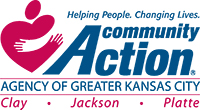The latest energy report indicates gas, coal, and electricity prices are at their highest levels in decades. It seems like everything is on the rise from crime to prices to temperatures, including public opinion. And if you’re paying the slightest bit of attention to your household bills I know this information is not new to you, but what will be is our new program, Weatherization Plus+.
We’ve been weatherizing homes in Platte, Clay, and Jackson counties for decades. And the Weatherization Assistance Program (WAP) has been operating within the Community Action Network since 1976. As a matter of fact, Community Action Agency of Greater Kansas City leads the State of Missouri in weatherizing homes, and we’re pleased to be able to provide communities with quality work, outstanding service, and lower energy bills.
So, what’s the Plus+? Well, we’ve added our Healthy Homes department services to the already extensive checklist of typical weatherization measures. Our standard weatherization measures include mechanical, building shell, electric and water, and client education. And now, every home weatherized will automatically receive health and safety measures.
This means not only are we repairing, replacing, upgrading, and fixing the problems in a home causing energy and money loss, we’re ensuring the home is a safe and habitable place which can also save on healthcare costs. We can thank COVID-19 for making us aware of germs again, reminding us to wash our hands frequently, cover our mouth and nose when we cough or sneeze, and to take extra measures to stay healthy and safe.
Clean, dry, contaminate-free, and organized environments help those dealing with health issues such as asthma, cancer, mobility issues, mental health, and other injuries thrive. Our Healthy Homes department provides every home with the necessary equipment, information, and know-how conducive for a healthy dwelling. The pandemic augmentd anxiety and depression for many, which had devasting effects on households. Healthy Home managers identify and assist recipients with issues they are unable to manage or secure resources to correct.
We had a 19-point weatherization measures checklist and we’ve expanded it with the addition of Healthy Homes measures to a 26-point checklist with good measure. Families, individuals, the aging, and incapacitated persons will greatly benefit from our new program. I strongly encourage you to apply for the Weatherization Plus program at www.caagkc.org or refer a friend. The State of Missouri has raised the federal poverty guideline to 200%, so if you didn’t qualify in the past, try again.
Your home is not only your shelter, it should be your place of peaceful rest and refuge from a chaotic world, enjoy it.
Clifton Campbell
Executive Director


